Raw milk yogurt has a thin, delicate texture and a lovely, light tartness. You can make it at home very easily. Serve it plain with fresh fruit and a drizzle of honey or make homemade yogurt panna cotta for a special dessert.
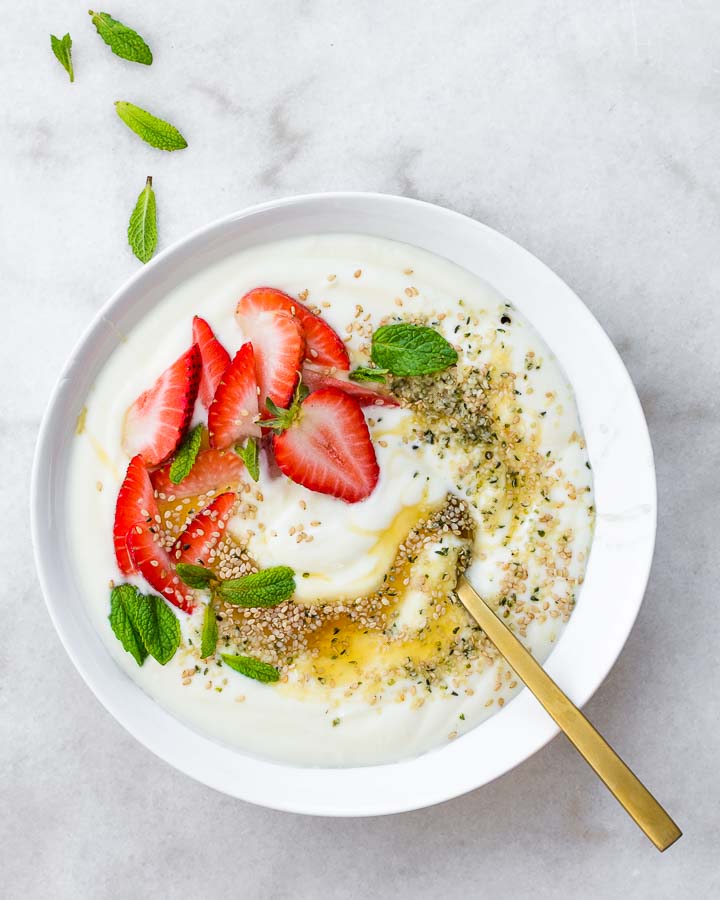
What is raw milk yogurt?
Raw milk yogurt is yogurt that has been prepared using raw, rather than pasteurized milk. It has a thin, drinkable consistency similar to milk kefir, and a lightly tart flavor.
Like homemade yogurt made with pasteurized or scalded milk as well as other cultured dairy products, it's very high in food enzymes and beneficial bacteria.
How is it different?
Traditionally, you make yogurt by whisking the starter into pasteurized or scalded milk. After that, you let it culture for 6 to 12 hours. Scalding or pasteurizing milk denatures its proteins. This process makes them "sticky." Accordingly, it's easier for those proteins to coagulate, or thicken as the milk cultures. The result is classic, thick and spoonable yogurt.
When you make raw milk yogurt, you whisk the starter directly into raw or unpasteurized milk. And since the proteins remain in their natural state, they don't coagulate resulting in a thin, rather than thick texture.
Raw milk yogurt also tends to be richer and has a more diverse array of bacteria than yogurt made from pasteurized milk.
Bacteria and Raw Milk Yogurt
Raw milk is naturally rich in bacteria, with some samples containing hundreds of varieties. For the most part, these bacteria are benign or even beneficial, but they can also be a source of pathogenic bacteria that cause serious food-borne illnesses (1).
When you make yogurt, you inoculate milk with a starter culture that's rich in specific beneficial bacteria that will give your yogurt flavor, texture, and many health benefits, too.
These starters include probiotic strains with strong anti-inflammatory activity. That's why yogurt is considered a nutrient-dense functional food. And the bacteria in yogurt help support optimal weight while improving gut, cardiovascular and metabolic health (2). These benefits aren't exclusive to yogurt made with raw milk.
Your Starter Culture
When you make yogurt the traditional way with scalded milk, you can save a little bit of that yogurt to make your next batch. In this way, starter cultures can become heirlooms - preserved and passed on. These starter cultures contain specific strains of bacteria that give your yogurt consistency in flavor and texture.
Raw milk already contains a very wide variety of native bacteria. When you use it to make yogurt, those native strains mix with the strains in your starter culture. Over time, the native bacteria in your raw milk may outcompete the strains in your starter, producing off-flavors and inconsistent results.
So, for consistent results, it's best to use a new starter each time you make yogurt rather than preserving a little from one batch to the next.
Further, use the freshest milk possible rather than old or sour raw milk. Bacterial counts in raw milk tend to grow rapidly in just a few days. Accordingly, these cultures may interfere with the bacteria in your starter culture, creating undesirable flavors or textures.
Pro Tip: Direct-set starter culture works best for raw milk yogurt and is the easiest option.
Making Raw Milk Yogurt
It's easy to make raw milk yogurt. First, you'll need to whisk your starter into your milk, and then let it culture.
Most yogurts culture best at a slightly elevated temperature of about 110 F. So, for best results, you'll need a way to keep your yogurt at a consistently elevated temperature. Some people use a thermos or tuck their jar of inoculated milk into the oven with the pilot light on, but a yogurt maker is a great purchase.
You'll know your yogurt is ready when it smells and tastes pleasantly sour, and set.
Try these yogurt recipes next
How to Thicken Raw Milk Yogurt
Raw milk yogurt is naturally thin with a drinkable consistency. And for many yogurt makers, this thin consistency is undesirable.
- Scald your milk first and then cool it down. Heat your milk to 180 F and then cool it down to 110 F. Your milk won't be raw any longer, but you'll make delicious yogurt with a thick consistency.
- Strain your yogurt. Line a fine mesh sieve with a butter muslin, and then pour the yogurt into the muslin, allowing the whey to drip. Depending on how well the yogurt set, you may lose a significant amount.
- Add raw cream. Substituting half the milk for cream can result in a thicker yogurt.
- Add gelatin. Place 4 teaspoons gelatin into a bowl, and cover it with ¼ cup raw milk until softened. Then whisk the bloomed gelatin into your milk as you heat it to 110 F. Culture normally, and set in the fridge at least 4 hours before serving.
References
- Quigley, L., O'Sullivan, O., et al. (2013) The Complex Microbiota of Raw Milk. FEMS Microbiology Reviews. 37(5). 664-698
- Pei, R., Martin, D.A., et al. (2013) Evidence for the Effects of Yogurt on Health and Obesity. Critical Reviews in Food Science and Nutrition. 57(8)

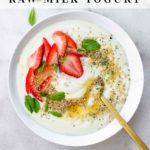
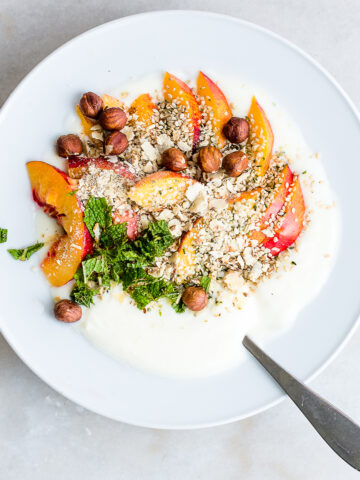
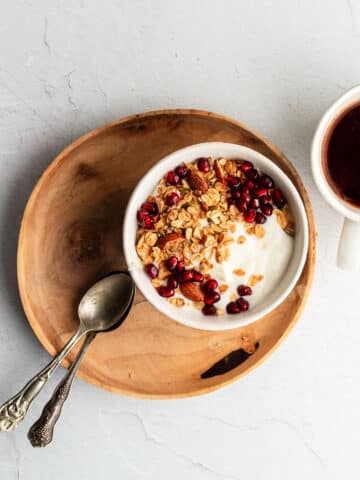

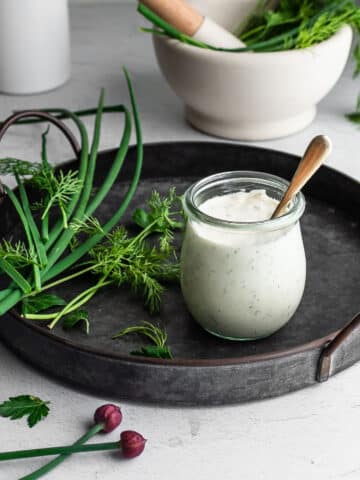
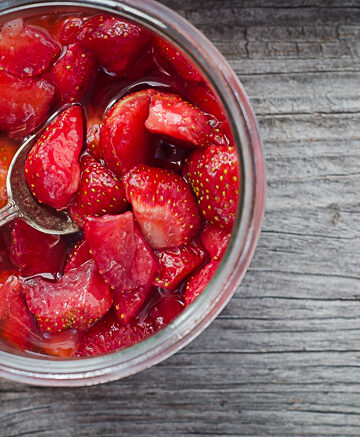
Ciera says
While heating my raw milk to 180 degrees it curdled. It was older milk- but still fine. Will the yogurt still work out? Any ideas what I should do?
Jenny McGruther says
You should only make yogurt with fresh milk. Old or sour milk will curdle like cheese because it has been acidified. You can turn it into a cottage-like cheese, but it is not approperiate for yogurt.
Isabella says
There's no need for a starter when making raw yogurt. Just pour some fresh raw milk into a glass container, place a lid on top (not tight) and let it sit out on the counter for 3 to 4 days. Wah-lah! Sour cream on top and fresh raw yogurt and whey on the bottom.
Jenny McGruther says
Hi Isabella. The name for what you are making isn't "raw milk yogurt." What you're making is "bonny clabber." Yogurt is cultured with a starter while clabber is a wild ferment reliant on the natural bacteria in the milk.
Lisa McDonald says
I have been making raw milk yogurt for years. I use 1/4 cup yogurt as the starter. My yogurt comes out thick and tasty. I then strain it to make Greek yogurt. I use the whey (liquid) in my morning smoothies.
Julia says
Loved this recipe. Been using raw milk for years but never got around to making yogurt.
PRM says
Thanks for this recipe! I have been trying to get yogurt to work with my whole/raw milk and this recipe lists helpful workarounds.
The real take away here is that if you want to make yogurt without having to add gelatin, cream and without having to strain it, use pasteurized milk.
Economically, for my $7 gallon of whole/raw milk, it's not worth it. I can use a $3 gallon of nerdy store-bought milk and beat the price of a gallon of Desi Dahi by half.
On the other hand, when I am looking to make buttermilk or kefir, raw milk is great. No stove required. Put your starter in with your milk and put it outside for 18-24 hours. One thing experience has taught me - room temp will get you buttermilk, outside summer (~80F) will get you kefir - which pours on granola, makes great lassi or ayran, and does lots of jobs fine. But for thick yogurt, Dahi or Greek style, it's simply not the thing to use.
Amber says
So tried this and it was *really* runny. I know that you say raw milk produces a thin yogurt, and it smelled sour and tasted like regular yogurt, but it was more like a drink. I think I'll try straining it next time.
jenny snow says
It was helpful
Kristi Wheeler says
I was given some raw milk, and decided to make some yogurt with it. You post is very helpful thank you so much!
Christine P says
I made my first batch of yogurt using fresh, raw milk. It didn't turn out as smooth as the yogurt I've made with store bought milk. Is that normal? Still tastes delicious though!